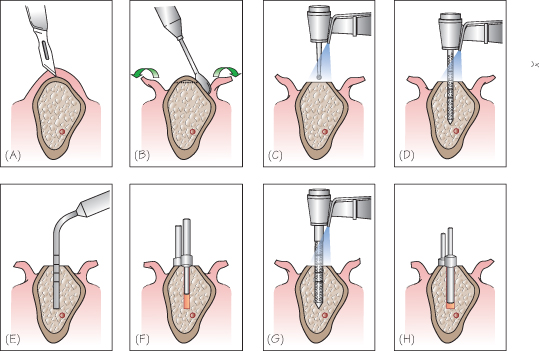33
Surgical techniques: the standard protocol
Rationale
The rationale for dental implant placement is based on the osseointegration process as defined in Chapter 1. Various dental implant systems are commercially available. Surgical techniques may vary according to the implant brand. However, some basic surgical guidelines can be set to define a standard protocol corresponding to a late implantation procedure.
Products and Devices
An implant system should be selected according to the available scientific background, ease of use in surgical practice, cost benefit, and the ability of the company to insure follow-up of the products. Not all commercially available implant systems meet the basic selection criteria.
Generally, the dental implant tray includes the following:
- disposable drilling kit
- screw-taps
- screwdrivers
- drill extension
- handpiece connectors or implant drivers
- ratchet extension
- direction indicators
- depth gauge
- ratchet wrench.
In addition to the above implant instruments, the surgical equipment includes a basic surgical kit (see Appendix B) and a surgical drilling unit.
Technical Procedure
Soft Tissue Elevation and Preparation of the Alveolar Ridge
A mid-crestal incision is made in the keratinized tissue (Fig. 33.1A). A mucoperiosteal flap is elevated without releasing the incision (Fig. 33.1B). After opening the gingiva, the alveolar ridge is prepared with a large round burr or a bone chisel in order to obtain a flat bone surface (Fig. 33.1C). The surgical template is placed.
Figure 33.1 Standard protocol: surgical technique. (A) Mid-crestal incision in the keratinized tissue. (B) Mucoperiosteal flap elevation. (C) Alveolar ridge preparation to obtain a flat surface (if necessary) followed by perforation of the cortical bone at the exact implant location. (D) Drilling (Ø 2 mm) to the appropriate depth and direction. (E) The depth gauge is inserted in the implant bed to check the drilling depth. (F) The direction indicators are placed in the sites to verify the parallelism and direction of the implants. (G) Drilling is continued to the desired final diameter (pilot drills may be used). (H) Before implant placement, direction indicators confirm the final implant bed.

Stay updated, free dental videos. Join our Telegram channel

VIDEdental - Online dental courses


